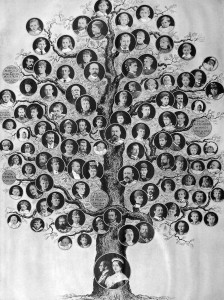 A decorative family tree created for Queen Victoria's Diamond Jubilee in 1897. Queen Elizabeth II's father, the future King George VI, may be seen at right, about half-way up the tree. R. Stanton Avery Special Collections, NEHGS
A decorative family tree created for Queen Victoria's Diamond Jubilee in 1897. Queen Elizabeth II's father, the future King George VI, may be seen at right, about half-way up the tree. R. Stanton Avery Special Collections, NEHGS
Later on today, Queen Elizabeth II’s reign will surpass the reign of her great-great-grandmother Queen Victoria in length. While the British throne has known many monarchs of short duration – the queen's uncle, King Edward VIII (1936), comes readily to mind – it is interesting to note that the House of Hanover/Saxe-Coburg-Gotha/Windsor has produced a king and two queens who ruled for more than fifty years each: George III (1760–1820, 59 years and 96 days), Victoria (1837–1901, 63 years and 216 days), and Elizabeth II (1952–, 63 years and 215 days … and counting).[1]
Queen Elizabeth grew up around a number of people who had known Queen Victoria well, including Victoria’s younger children Princess Louise, Duchess of Argyll (1848–1939); Prince Arthur, Duke of Connaught (1850–1942); and Princess Henry of Battenberg (Princess Beatrice, 1857–1944). Queen Elizabeth’s own grandmother, Queen Mary (1867–1953), was the daughter of Victoria’s first cousin,[2] and she knew the queen well even before she married the future King George V in 1893. Yet another connection comes through the family of Prince Philip, Duke of Edinburgh: his grandmother, who in part brought him up, was one of Queen Victoria’s eldest grandchildren, Princess Victoria of Hesse-Darmstadt (1863–1950), successively Princess Louis of Battenberg[3] and Marchioness of Milford Haven. Through each of these relatives, and doubtless many others inside and outside the modern royal family, the queen will have derived a sense of her legendary predecessor.
For to a remarkable degree, the senior British royal family still lives in a social round laid down by Queen Victoria and her husband, Prince Albert of Saxe-Coburg-Gotha (1819–1861). True, they no longer summer at Osborne on the Isle of Wight, and they prefer King Edward VII’s Norfolk estate of Sandringham for Christmas, but Queen Elizabeth and Prince Philip also live at Buckingham Palace in London, Windsor Castle in Berkshire, and Balmoral Castle in Aberdeenshire – just as Victoria and Albert once did. Their private rooms, however changed since 1901 (or 1861), would still be familiar to their common great-great-grandparents – they are third cousins, both descended from Queen Victoria and Prince Albert – and many of the same festivals and holidays are, in 2015, enacted in the same places and style as they were more than a century ago, during the last long reign of a British monarch.
It doesn’t seem quite right to lapse into another language when writing about the present Queen of England (and many other places), but the French say it best: Plus ça change, plus c’est la même chose! And Vive la Reine!
Notes
[1] https://en.wikipedia.org/wiki/List_of_monarchs_in_Britain_by_length_of_reign. More information about the Diamond Jubilee family tree may be found here.
[2] Princess Mary Adelaide of Cambridge (1833–1897), who married the Duke of Teck in 1866. The present Princess Charlotte of Cambridge is the Duchess of Teck's great-great-great-great-granddaughter.
[3] Princess Victoria and her maternal aunt, Princess Beatrice of Great Britain (see above), married brothers. More information on the Teck and Battenberg families may be found here.
Share this:
About Scott C. Steward
Scott C. Steward has been NEHGS’ Editor-in-Chief since 2013. He is the author, co-author, or editor of genealogies of the Ayer, Le Roy, Lowell, Saltonstall, Thorndike, and Winthrop families. His articles have appeared in The New England Historical and Genealogical Register, NEXUS, New England Ancestors, American Ancestors, and The Pennsylvania Genealogical Magazine, and he has written book reviews for the Register, The New York Genealogical and Biographical Record, and the National Genealogical Society Quarterly.View all posts by Scott C. Steward →